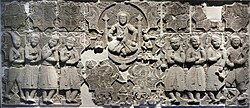Ikhshidid dynasty
[3] Muhammad ibn Tughj al-Ikhshid, a Turkic[4][5] mamluk soldier, was appointed governor by the Abbasid Caliph al-Radi.[12] The Fatimids were a major threat at the time and considerable effort was put into repelling them, culminating in their defeat by Ubayd Allah, ibn Tughj's brother, by November 936.[13] There was remarkable stability in the early years, with an absence of economic chaos and Bedouin raids, coupled with prohibition of looting, which helped pacify Egypt.Ibn Tughj sought the honorific title (laqab) of Al-Ikhshīd, which means "King of the Farghanians", from the Abbasids and official designation arrived in July 939.[16] In 944, the governorships of Egypt, Syria and Hijaz were awarded for 30 years to ibn Tughj's family, and these posts would pass to his son, Abu'l-Qasim.[24] The practice began with the Tulunids in 870 AD, where the Africans were used as infantrymen, and continued by the Ikhshidids due to financial reasons, as they were cheaper than Turkic military slaves which were used as cavalry.


Ikhshids of SogdiaMuhammad al-Ikhshidal-RamlaAbbasidAbbasid CaliphateFustatArabicCopticWestern AramaicTurkicCoptic OrthodoxMaronite ChurchWali (governor)Muhammad ibn Tughj al-IkhshidAbu'l-Qasim Unujur ibn al-IkhshidAbu'l-Hasan Ali ibn al-IkhshidAbu'l-Misk KafurAbu'l-Fawaris Ahmad ibn Ali ibn al-IkhshidFatimid conquestTulunidsFatimid CaliphateALA-LCmamlukLevantAbbasidsFatimidconqueredal-RadiJerusalemIkhshidMuhammad ibn TughjFerghanaAnarchy at SamarraAnarchySamarraMu'nis al-MuzaffarDamascusTinnisAhmad ibn KayghalaghAl-MuttaqiMuhammad ibn Ra'iqAbu'l-QasimSayf al-DawlaHamdanidsal-Muqtadir billahal-Radi billahDamietteNubianAbu'l-HasanIfriqiyaJawhar al-Siqillimanaged to conquer EgyptUbayd AllahJa'far ibn FallahAl-IkhshidIkhshididsAl-HasanAbu'l-MiskAbu'l-FawarisFatimidsHistory of the Turkic peoplesTurkic peoplesOnogursOghuz TurksSaragursUtigursBulgarsKutrigursKarluksKipchaksCherniye KlobukiUyghursTatarsKumyksYakutsDolgansKrymchaksCrimean KaraitesTurkic LanguagesTurkishAzerbaijaniKazakhUyghurTurkmenKyrgyzBashkirChuvashQasgqaiKarakalpakKarachay-BalkarGagauzKaraimKrymchakTurkic MythologyTengrismShamanismÜlgenErgenekonGrey wolfPre-14th centuryYenisei Kyrgyz PeopleYenisei Kyrgyz KhaganateDinglingTiele (Gaoche) GöktürksFirst Turkic KhaganateWestern Turkic KhaganateTokhara YabghusTurk ShahisEastern Turkic KhaganateSecond Turkic KhaganateSabiri PeopleKhazar KhaganateXueyantuoKangar UnionTurk ShahiTürgesh KhaganateKimek–Kipchak ConfederationUyghur KhaganateOghuz Yabgu StateKarluk Yabgu StateKara-Khanid KhanateGanzhou Uyghur KingdomPecheneg KhanatesGhaznavid EmpireSeljuk Empire